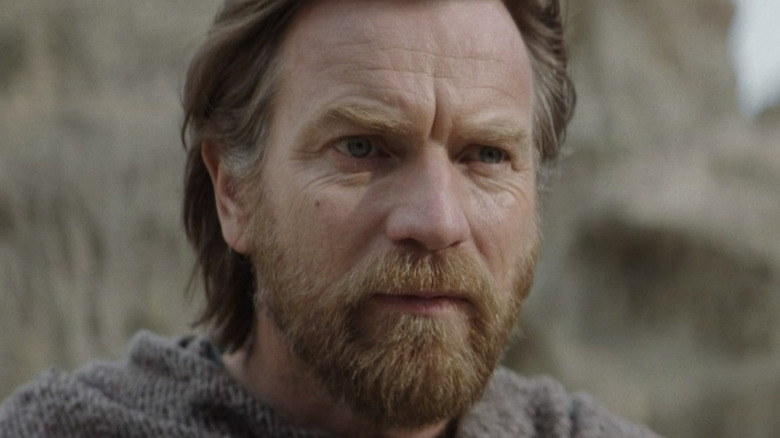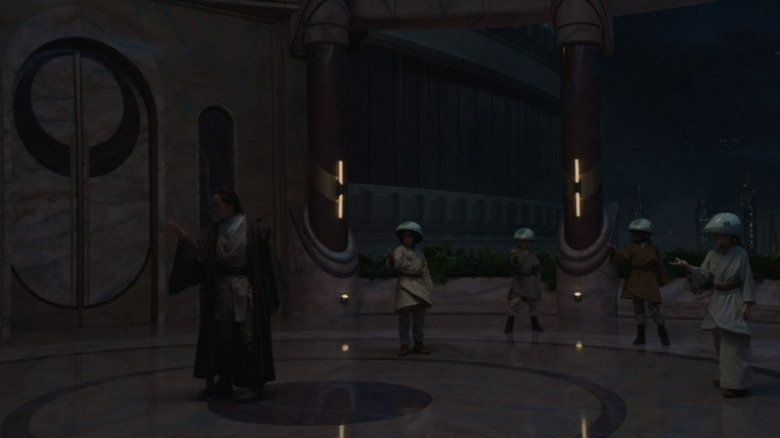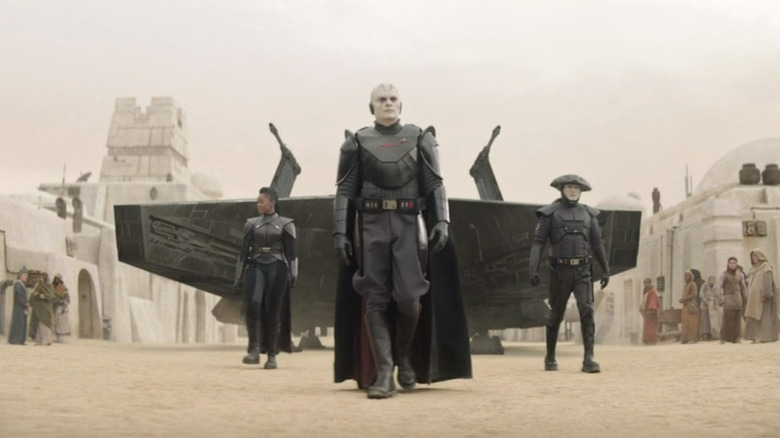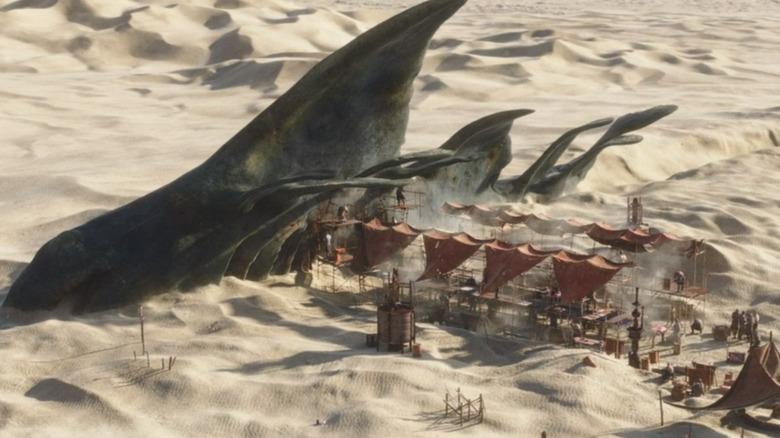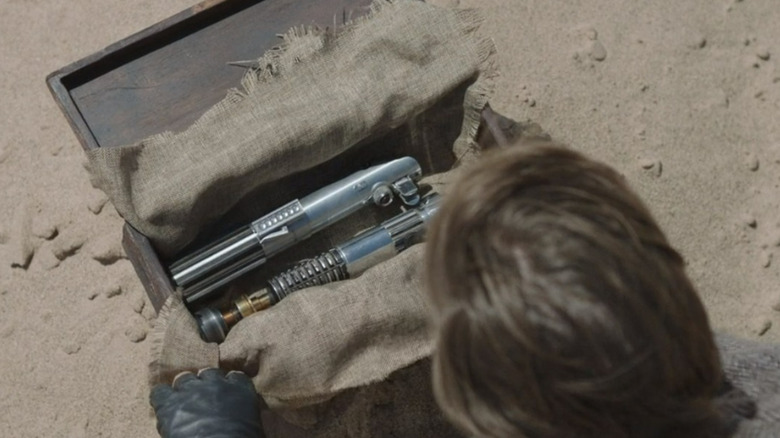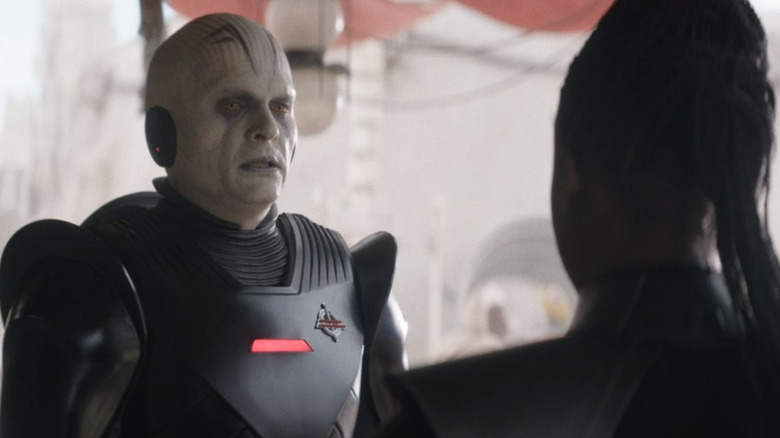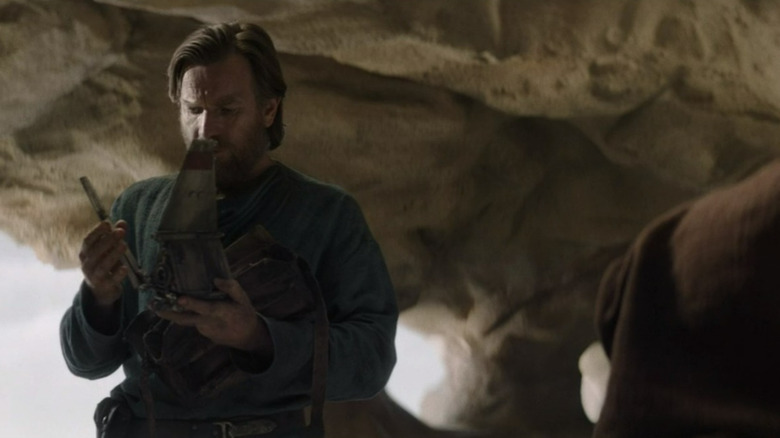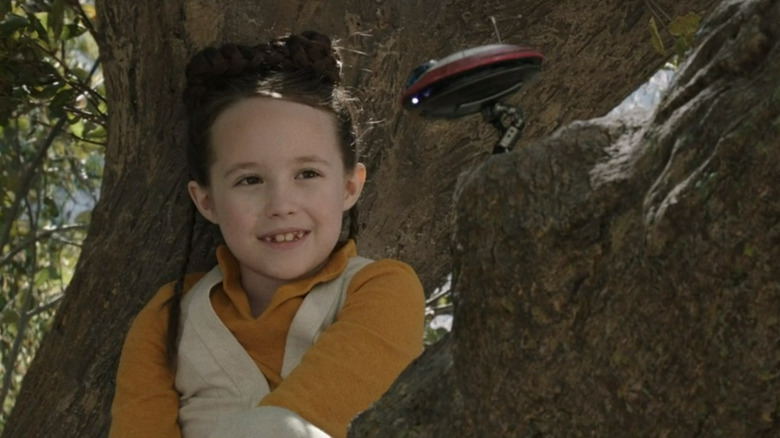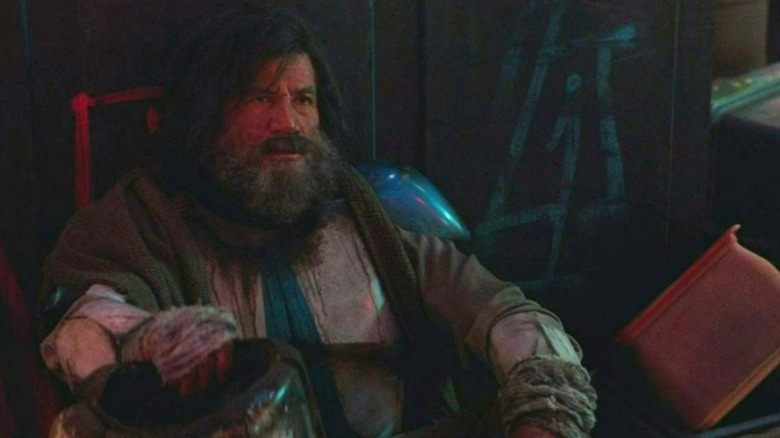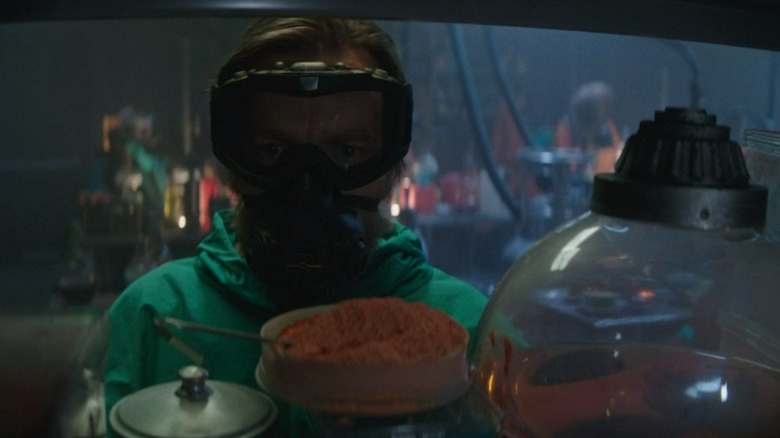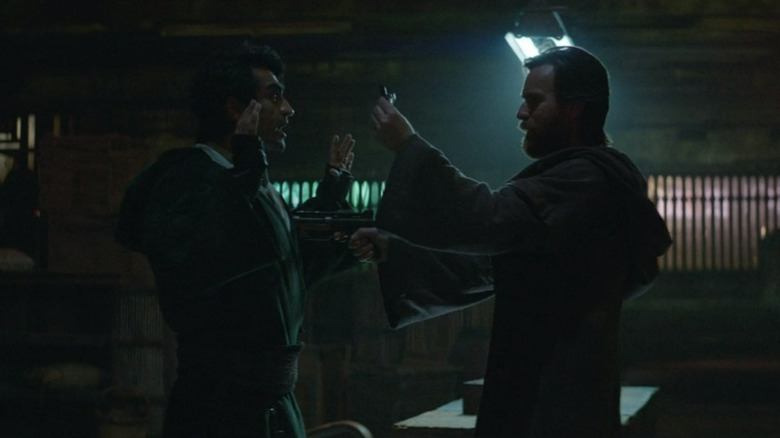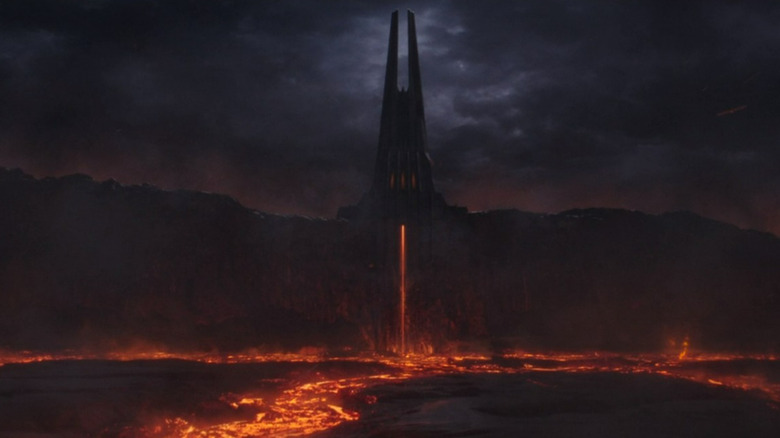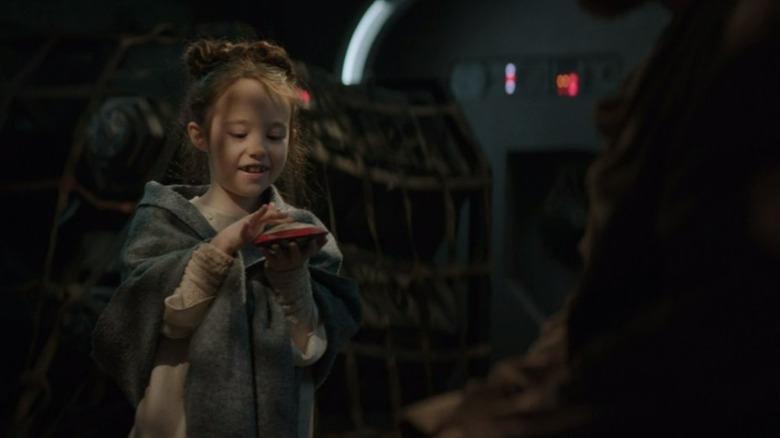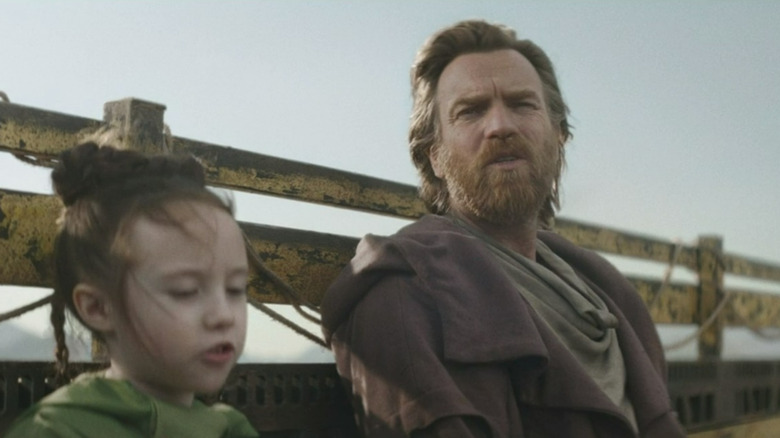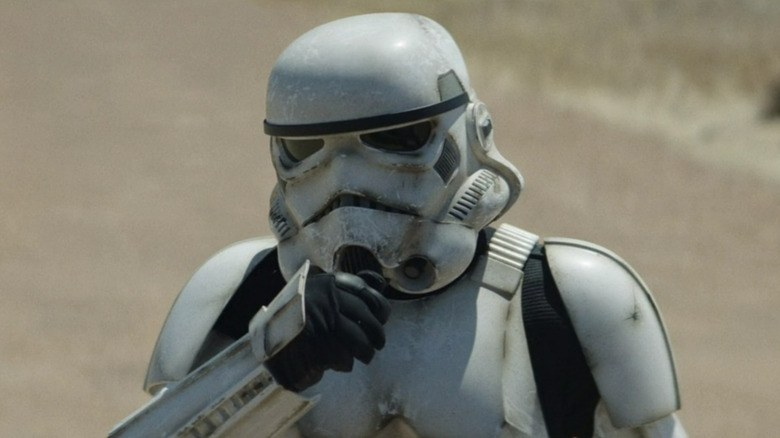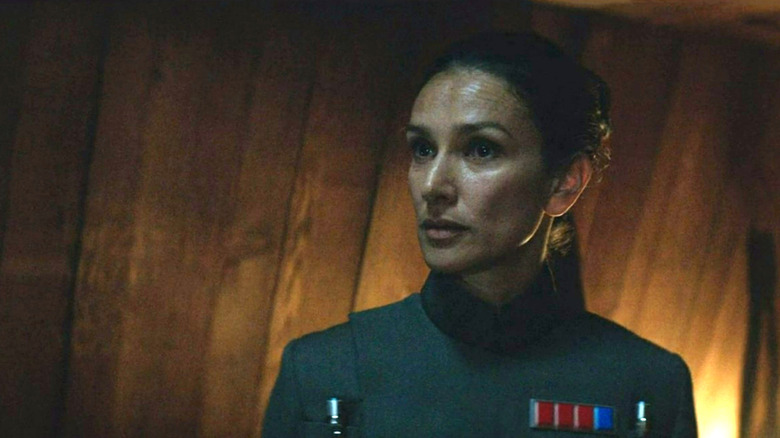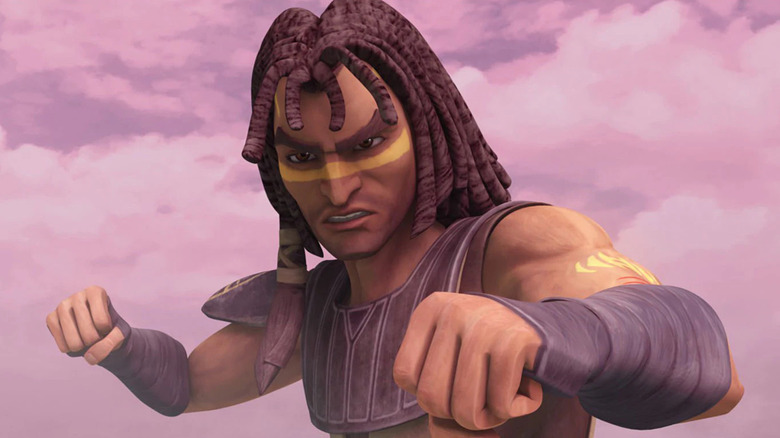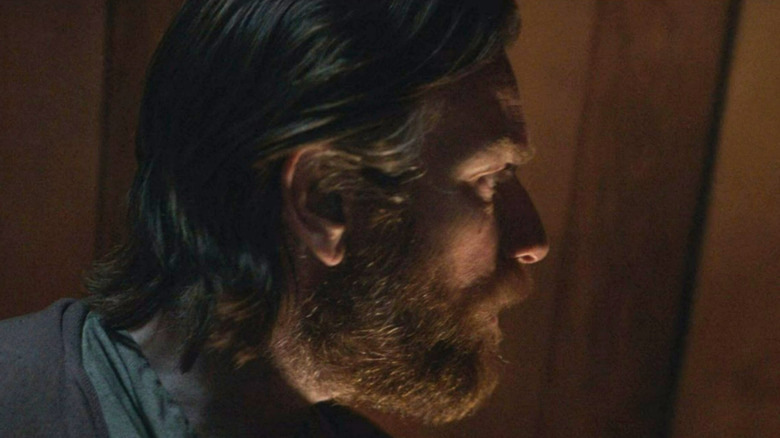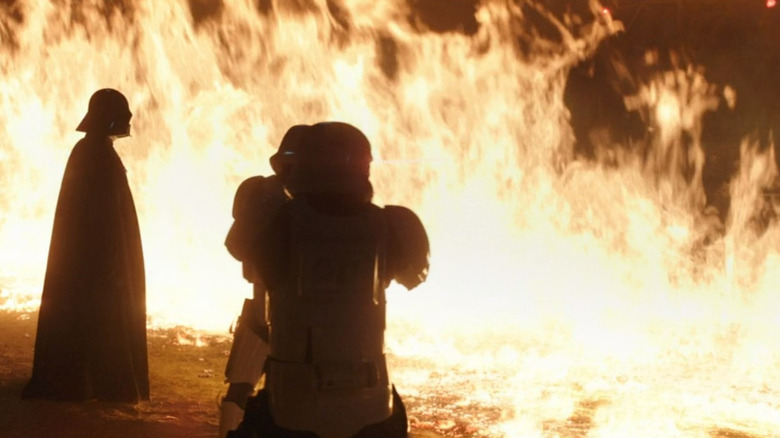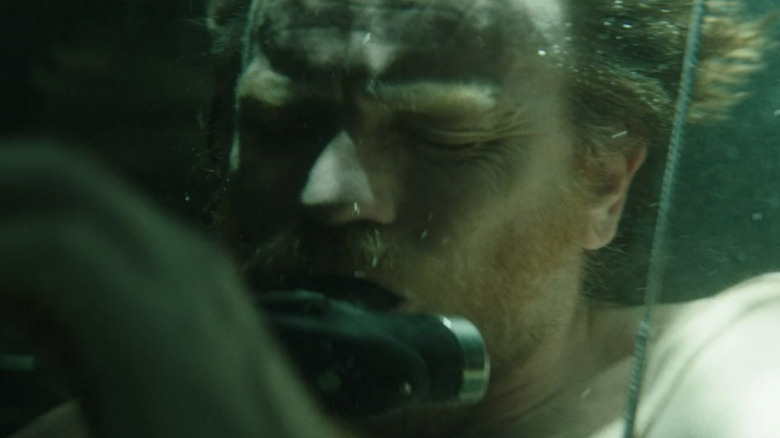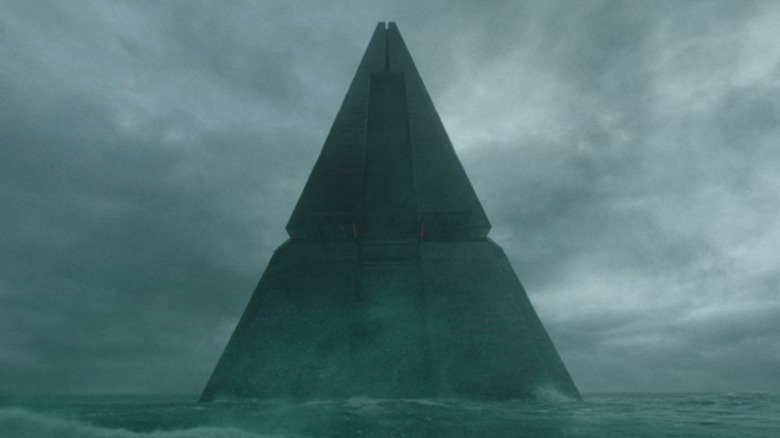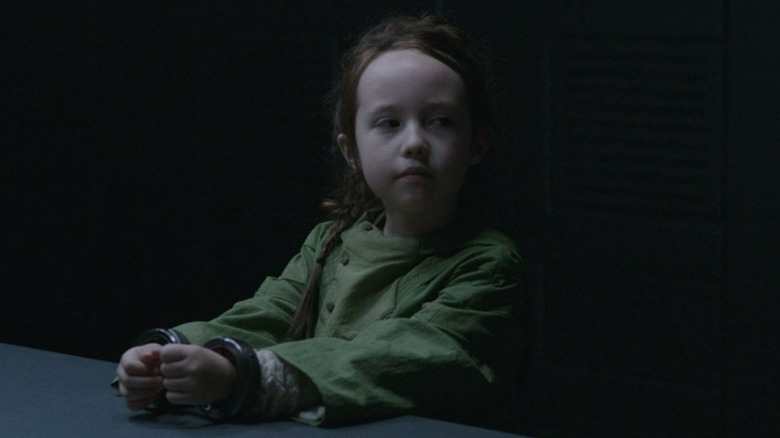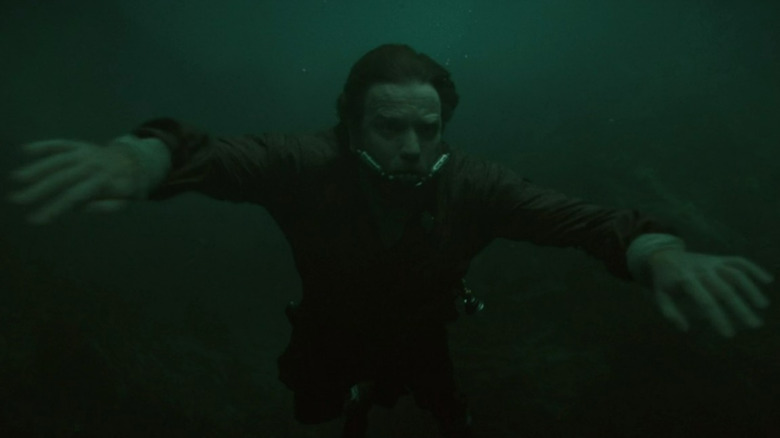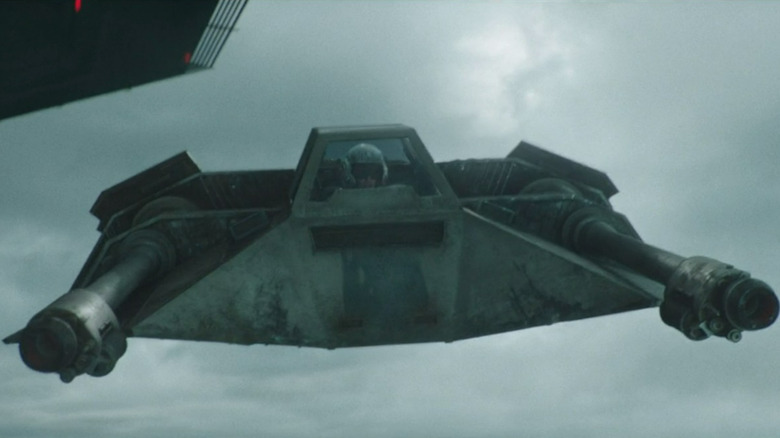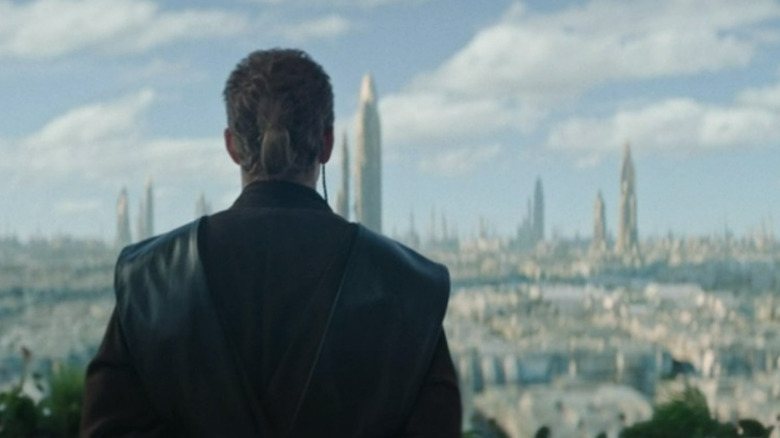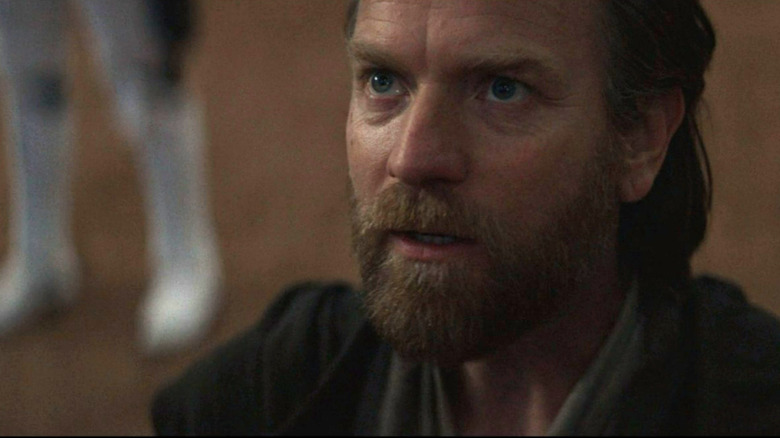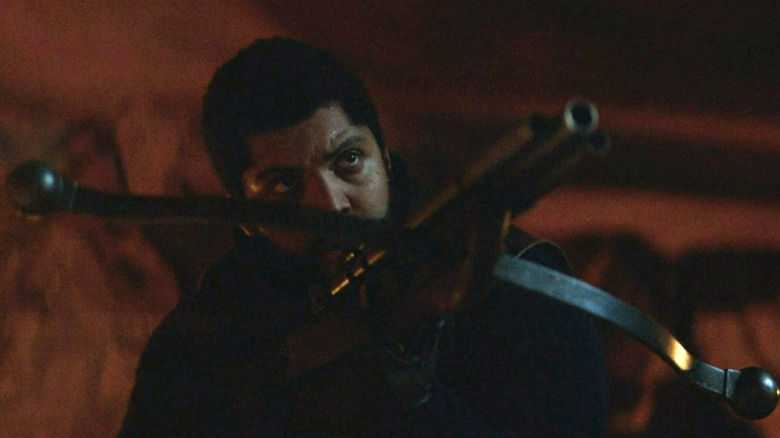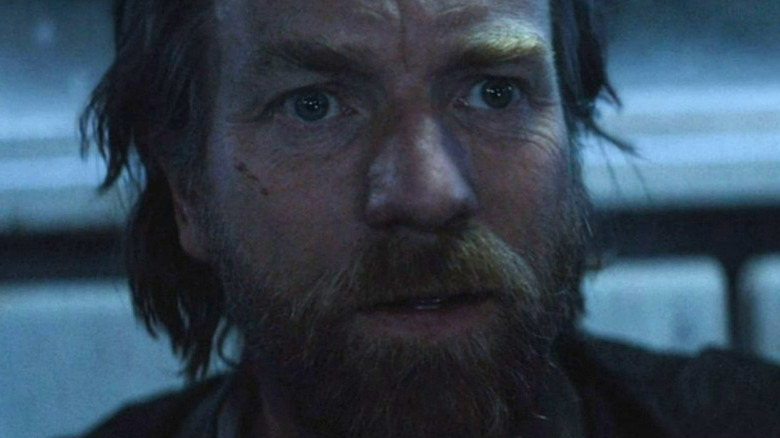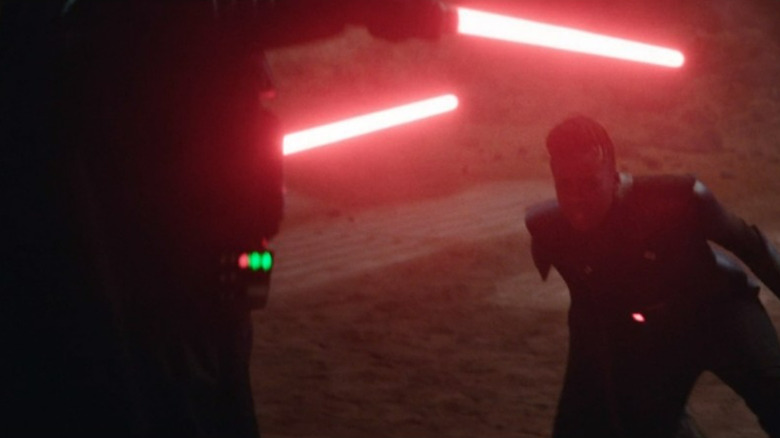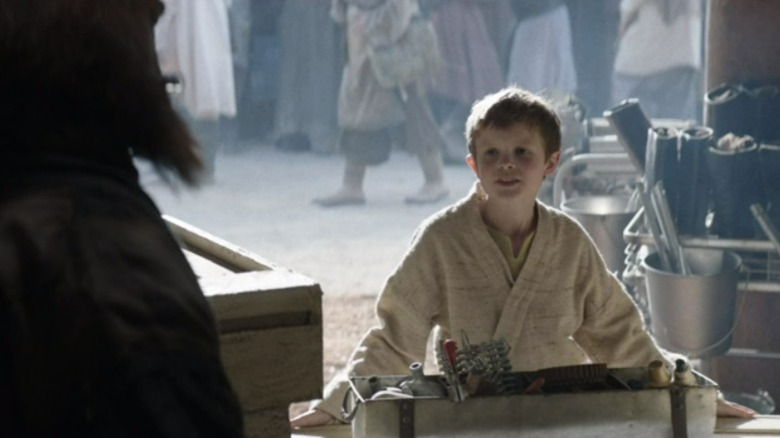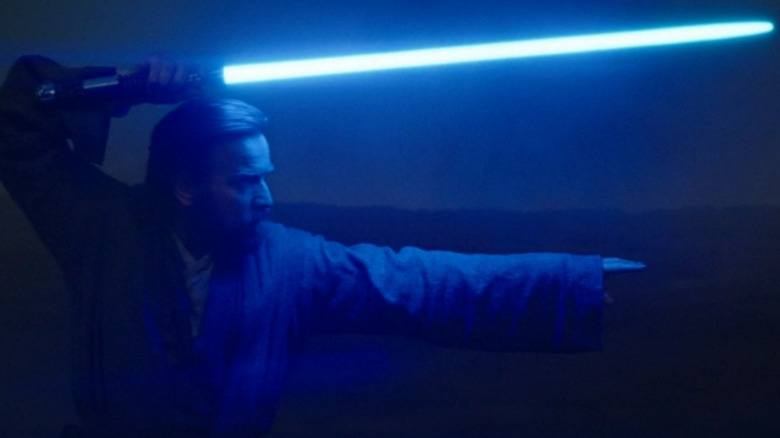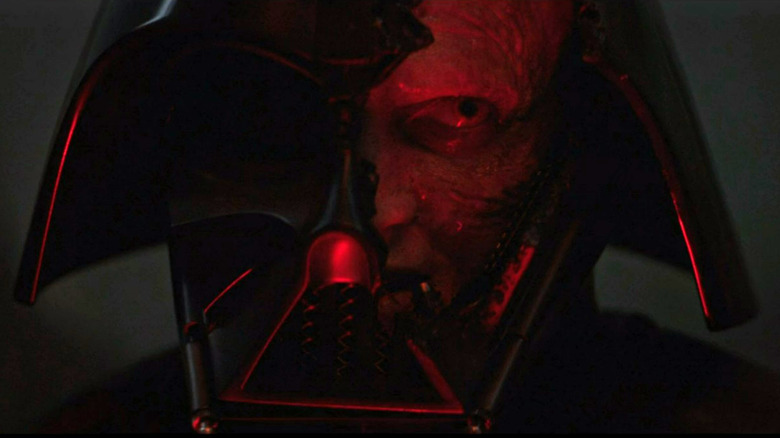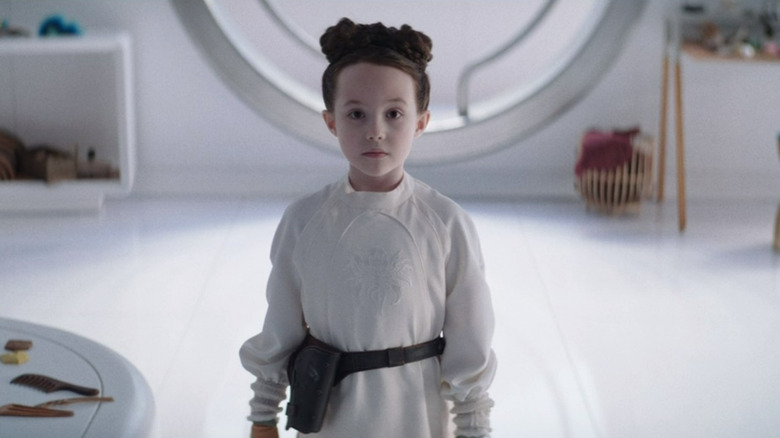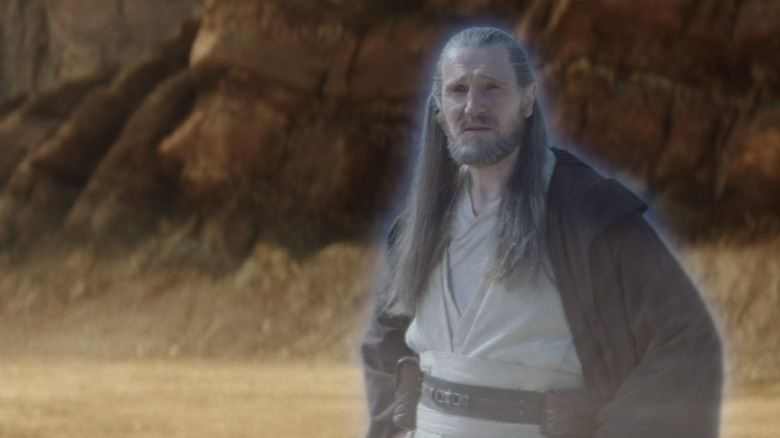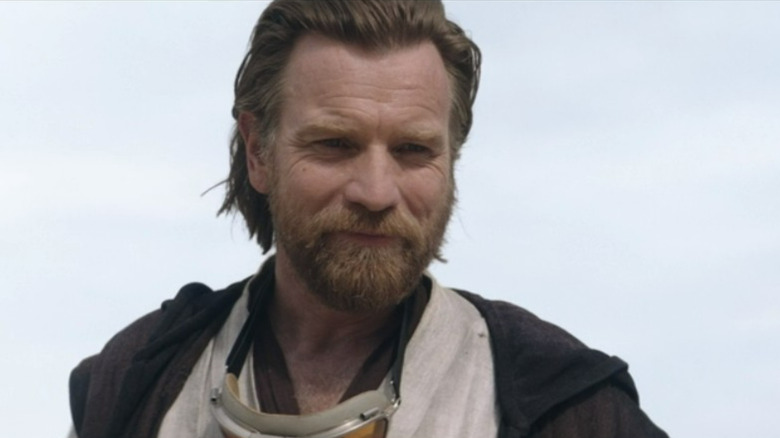Easter Eggs You Missed In Obi-Wan Kenobi
Ewan McGregor's return to "Star Wars" in the "Obi-Wan Kenobi" series has brought a number of new additions to the world and lore of the franchise, but it also pulls heavily from what's been established in the past. Set a decade after "Revenge of the Sith," the show follows Obi-Wan on a quest to save a young Princess Leia — and himself — from the brutal agents of the Empire. Along the way, old friends and foes alike return to the fold to reveal new corners of the "Star Wars" galaxy.
The era between the original and prequel trilogies has been explored a good bit in stories like "Star Wars: The Bad Batch," "Solo: A Star Wars Story," and "Star Wars Jedi: Fallen Order," but much still remains a mystery. Thanks to its position on the "Star Wars" timeline, "Obi-Wan Kenobi" gets to pull equally from all six of George Lucas' films. The Disney+ series shows a universe in transition — one that still resembles the Clone Wars era in many ways but is clearly headed toward the full-blown Imperial oppression seen in "A New Hope."
Given its midway setting, it makes sense that "Obi-Wan Kenobi" features a ton of references — both big and small — to all corners of the "Star Wars" mythos. From blink-and-you'll-miss-it moments to subtle homages, here are some Easter eggs you might have missed in "Obi-Wan Kenobi."
Be warned, there will be major spoilers ahead.
Order 66
"Obi-Wan Kenobi" starts out in a flashback set during "Revenge of the Sith" — specifically, the brutal assault on the Jedi Temple led by Anakin Skywalker himself. The scene shows a class of Jedi younglings training with a master in the ways of the Force. When the sounds of battle begin to intrude on the lesson, the master escorts her students through the halls of the temple, taking down several attacking clone troopers along the way. Tragically, she doesn't make it far before dying to a well-placed blaster bolt, leaving the younglings to fend for themselves.
In addition to showing a new angle on the events of Order 66, the flashback scene includes a couple of details that most fans of the "Star Wars" prequels should recognize. The helmets that the younglings are wearing, for instance, are the same ones worn by Yoda's students in "Attack of the Clones." The layout of the Jedi Temple, as shown in the escape sequence, also perfectly mirrors its portrayal in the prequel trilogy. Finally, the Order 66 scene sets the stage for the gross imbalance of power rampant during the Imperial era. Some of the younglings may have survived, but they would either become fugitives or Imperial Inquisitors.
A vessel fit for a Sith
After "Obi-Wan Kenobi" jumps to its main timeline on Tatooine, viewers are quickly introduced to the Imperial Inquisitors — Force-sensitive Jedi hunters trained in the ways of the dark side. The Third Sister (Moses Ingram), Fifth Brother (Sung Kang), and the Grand Inquisitor himself (Rupert Friend) all touch down on the desert planet in search of a rogue Jedi who, surprisingly, isn't Obi-Wan. The three dark side agents are shown disembarking from a stark ship that might look familiar to those who've seen "The Phantom Menace."
While certainly not the exact same design, the Inquisitors' ship resembles Darth Maul's Scimitar, which also made its "Star Wars" debut flying over the sands of Tatooine. Though the ship shown in "Obi-Wan Kenobi" is a bit boxier — a staple of Imperial design — its similarity to the Republic era Sith vessel is a nice touch. Visually, it sets the Inquisitors in a category of their own. They're agents of the Empire, yes, but they're also powerful dark side Force-wielders in their own right. The Darth Maul allusion is also particularly relevant to the story of Obi-Wan, as he's always been connected to Darth Sidious' original apprentice.
Scenic Tatooine
Disney+ has returned to Tatooine again and again in its various "Star Wars" shows, and while Obi-Wan quickly makes his way off the desert planet in his own series, he spends the whole first episode wandering the Dune Sea. At this point, Jawas and Banthas are a little too commonplace to count as Easter eggs, but there are still some fun little details waiting to be found.
The saloon that the Inquisitors infiltrate is a nice homage to the Mos Eisley cantina, complete with bright green drinks served in tall, opaque glasses. Obi-Wan's Jawa friend Teeka references the Jundland Wastes, which any good "Star Wars" fan knows are not to be traveled lightly. Additionally, there's a good sampling of the local Tatooine wildlife.
Obi-Wan earns a living by working on a butcher line, harvesting meat from the massive corpse of what appears to be a Krayt Dragon (or some similarly massive beast). His cruel overseer might conjure memories of Rey's portion-paying boss in "The Force Awakens." It's then revealed that Obi-Wan's main mode of transport is an Eopie — a long-snouted, camel-like creature first introduced in "The Phantom Menace." Eopies have historically been best known for their flatulence, but Obi-Wan fortunately seems to have acquired one with more decorum.
Old Ben
"Obi-Wan Kenobi" Episode 1 paints a pretty grim picture of the eponymous Jedi's life in exile. After a hard day at work, he returns to his hideout in the desert, which is little more than a furnished cave. Still, even amid the barrenness, Obi-Wan has retained some reminders of his old life, which include some interesting references to the "Star Wars" movies.
At the entrance to his home, there's a periscope scanner — presumably a security protocol to alert him to intruders. Fans may recognize the device's design, as an identical periscope is used repeatedly by R2-D2 throughout the "Star Wars" films. Hopefully, Obi-Wan's is simply a repurposed gadget and not the appendage of some poor astromech droid buried in the sand. Later in Episode 1, Obi-Wan takes out an old hologram communicator to receive a transmission from Bail Organa (Jimmy Smits). It's another device that should be familiar to those who've seen the movies, as Obi-Wan is seen using it in the prequel trilogy.
Perhaps most striking of all, however, is the cloud of defeat that follows Obi-Wan. Under his Ben persona, the Jedi truly looks like he's given up. He's buried his and Anakin's lightsabers in the desert (a possible allusion to the end of "The Rise of Skywalker"), he's terrorized by nightmares, and he is hesitant to use the Force in basically any scenario. Given how calm and controlled Obi-Wan is in "A New Hope," it's interesting to see him in such a dark place.
The Inquisitorius
If you've absorbed much "Star Wars" media in the Disney era, then you're probably familiar with the Imperial Inquisitors. Moses Ingram's Reva, who takes the villainous lead in the Disney+ series, is a new addition, but some of the Emperor's agents have appeared in the past. Sung Kang's Fifth Brother, for instance, has featured in several previous projects, including the "Darth Vader" comics and "Star Wars Rebels." He eventually meets his end at the hands of Darth Maul — a curious twist of fate given their shared history of hunting for Obi-Wan.
The Grand Inquisitor — another prominent villain from the "Star Wars" comics and "Star Wars Rebels" — also makes his presence felt in the "Obi-Wan" show. However, he's a bit different this time around. In "Star Wars Rebels," the Grand Inquisitor is voiced by Jason Isaacs, and some fans were upset when he was recast with Rupert Friend for the live-action version. After being stabbed by Reva in a surprising betrayal, the Grand Inquisitor disappears from the story, but he doesn't stay down for long.
Both the Fifth Brother and the Grand Inquisitor wield the same spinning lightsabers first shown in "Star Wars Rebels," and they look a bit more intimidating in live-action.
It's just a toy
One of the more touching moments in "Obi-Wan Kenobi" Episode 1 comes during Ben's interaction with Teeka the Jawa. He spends a good portion of his hard-earned money to buy a toy for the young Luke Skywalker, and not just any toy either.
Specifically, Obi-Wan purchases a model of a T-16 Skyhopper — a small airspeeder first mentioned in the original "Star Wars." Luke references the craft during the briefing for the first Death Star attack, claiming that "I bullseye womp rats in my T-16 back home." He's also shown playing with a toy version of the speeder during an early conversation with C-3PO. It seems that Obi-Wan was the giver of that gift all along, which is a fun little twist on a tiny piece of preexisting lore. Though Luke's Uncle Owen (Joel Edgerton) insists that Obi-Wan takes the toy back, it seems that he acquiesces in the end.
The Princess of Alderaan
A lot of "Star Wars" media has dealt with Luke's time on Tatooine, but far less time has been spent exploring his sister Leia's upbringing on Alderaan. "Obi-Wan Kenobi" addresses that by spending a good amount of time on the planet, following a 10-year-old Leia through the ins and outs of her royal life. Young star Vivien Lyra Blair does an excellent job bringing the young Princess to life, complete with Leia's signature snark, stubbornness, and wit.
In one scene, while climbing a tree with her little droid friend Lola, Leia starts naming the ships she sees leaving the local spaceport. She identifies an "Aquilian ranger, probably scouting for Merson pirates." The mention of Aquilian rangers is a deep-cut reference to the Aquilae System, first mentioned in an infamous cut line from the original "Star Wars." Merson pirates appear in some early "Star Wars" comics that have since been relegated to the "Legends" timeline, though they have also been referenced in canonical media.
It's also worth noting that, in an attempt to avoid her adoptive parents' impending political reception, Leia sends a young decoy to be dressed and ornamented in her place — the exact same tactic her mother Padmé used many times throughout her political career. Leia quickly reminds Obi-Wan of Padmé after they meet, and it's clear why.
The war veteran
Soon after arriving on the crime-ridden world of Daiyu, Obi-Wan sees a face he certainly didn't expect — that of an old clone trooper begging for money on the side of a dirty street. Though the former Republic soldier (played in a special cameo by Temuera Morrison) is technically much younger than Obi-Wan, he looks notably older, as his body has broken down due to the Kaminoans' accelerated aging alterations.
It's a powerful and somewhat horrific reminder of what happened to the clones after the rise of the Empire. As shown in "Star Wars: The Bad Batch," most were quickly phased out of military service. It is clearly jarring for Obi-Wan to see the old clone, which makes sense given his complicated history with them. On the one hand, he probably saw his old friends Cody and Rex in the beggar's face and felt quite sad. On the other hand, the events of Order 66 would surely have created a traumatic connection to the clones. Obi-Wan moves on from the encounter quickly, but it surely stays with him — especially since the clone's blue-accented armor is remarkably similar to Rex's.
The spice trade
If there's underworld activity happening in a "Star Wars" story, there's a good chance it has something to do with spice, the all-purpose drug signifier stolen (along with many other things) straight out of "Dune." That rule holds true in "Obi-Wan Kenobi" as well, with the spice trade rearing its head immediately on Daiyu. A young dealer tries to sell the rogue Jedi some of the stuff, naming a few different varieties, including Kessel (a primary spice planet most famous for the Kessel Run) and Felucian (a reference to the planet Felucia, where Jedi Aayla Secura met her unfortunate end during Order 66).
Later on, Obi-Wan infiltrates a spice lab and even uses a vial of the stuff to fend off a group of would-be captors. He smashes the small glass container on the ground and locks his attackers in with it, sending them all on what looks to be a pretty intense trip.
Uncivilized weapons
Less an Easter egg than a fun little detail, this one's still worth mentioning given the main character in the series. In the original "Star Wars," Obi-Wan refers to Lightsabers as being from "a more civilized age" and claims that they're "not as clumsy or random as a blaster." This line is referenced again in "Revenge of the Sith" after Obi-Wan discards a used blaster and declares it "so uncivilized." It's interesting, then, that he uses blasters so prevalently in the first couple episodes of his own show.
As he doesn't want to out himself as a Jedi, Obi-Wan hesitates to use either the Force or his lightsaber. He instead relies on his martial arts prowess (Teräs Käsi, anyone?) and what weapons he can find to keep the bad guys at bay. More importantly, Obi-Wan doesn't complain once about the blasters he's forced to use — almost as if he's let go of his old Jedi pride. It's a small detail, but it helps build the sense that he's really given up all hope. If Obi-Wan Kenobi can use a blaster without a snide comment, things truly have taken a dark turn.
Fortress Vader
At the beginning of "Obi-Wan Kenobi" Episode 3, Darth Vader is shown conducting business with his Inquisitors from his remote citadel on Mustafar — the site of his greatest defeat. The castle, officially known as Fortress Vader, has appeared once before in live action as part of Vader's arc in "Rogue One." For the most part, though, it's remained apart from the franchise's biggest installments.
If you've read the "Darth Vader" comics, however, you'll be much more familiar with all the ins and outs of Fortress Vader. Not only is the citadel constructed on the planet where Anakin Skywalker fell to his former master, but it also has a strong connection to the dark side. The fortress was designed by an ancient Sith Lord named Darth Momin, with Vader using that original design as a blueprint for his own construction. The site of the fortress is located over an old Sith cave, which connects it to the pure energy of the dark side. In this way, Fortress Vader represents Vader's fall as well as his complete embrace of his Sith persona. When he discovers Obi-Wan's location, he brings the full brunt of that anger and anguish to bear in his hunt for the Jedi.
Life's always simpler when you're fixing things
While on the transport ship from Daiyu to Mapuzo, Obi-Wan has a bit of a restless time. The revelation that Anakin survived their duel on Mustafar shakes him to his core, and despite how hard he tries, he can't reach Qui-Gon's spirit through the Force. So what does he do to try to calm himself in a moment when everything feels out of control? He fixes Leia's little droid friend, Lola. After all, life's much simpler when you're fixing things.
It's possible that Obi-Wan simply wanted to fix the droid for Leia's sake, but given that Anakin has a whole monologue in "Attack of the Clones" about the therapeutic merits of tinkering, there's probably a bit more going on. Maybe it's subconscious — maybe Obi-Wan resorts to one of his old friend's habits to try to assuage the guilt of his role in Anakin's fate. Maybe he wanted to remember the parts of him that were good. Or maybe he simply adopted the habit of fixing things in moments of duress after all the years he spent with Anakin. Either way, his repair of Lola is a quietly powerful moment, showing just how deeply Obi-Wan grieves the loss of his former apprentice.
Obi-Wan's childhood
At one point in "Obi-Wan Kenobi" Episode 3, he discusses his life before joining the Jedi Order. He tells Leia that he was incredibly young when he was taken to start his training, so he only remembers very brief and fleeting images from his original life. He remembers his mother's shawl, his mother's hands, and a baby who he believes to have been his brother. The details elude him, and he doesn't even name a home planet, but it's interesting to hear him speak even fleetingly of this period.
In the old "Star Wars" Legends timeline, which is no longer canon, Obi-Wan was taken by the Jedi while still essentially an infant. It seems, then, that the current canon is changing things up a bit and making his discovery by the Order a little later in his life. It's also possible that the memories Obi-Wan has of his family are in fact visions from the Force of something else entirely — possible futures or other things from the past that connect to him in different ways.
It's also interesting that Obi-Wan doesn't name his home world when talking to Leia. While being interviewed by comedian and political commentator Jon Stewart at a "Star Wars" event, George Lucas once claimed that Obi-Wan's original planet was called "Stewjon" — a clear joke playing on Stewart's own name. Stewjon nevertheless became inserted into the "Star Wars" lore and has yet to be officially retconned as Obi-Wan's birth world.
Imperial gear
Because it's set well into the Imperial era, "Obi-Wan Kenobi" features a lot of gear that's pulled straight out of the original trilogy. For instance, in Episode 3, Imperial probe droids identical to the ones seen in "The Empire Strikes Back" are sent out to hunt for Obi-Wan and Leia. These droids are also launched from a complicated facility that may or may not be an intentional homage to the droid factory from "Attack of the Clones."
Later in the same episode, while wandering the planet Mapuzo, Obi-Wan and Leia come across a couple different squads of stormtroopers. Obviously, their armor and blasters is the same as they appear in the original "Star Wars" films, but there are even smaller details worth noticing, like the tiny handheld communicators used by the Empire's soldiers. Identical devices are used in "A New Hope" during the rescue of Princess Leia from the Death Star.
Jabiim
The secret network of Jedi allies whose members aid Obi-Wan and Leia in their escape funnel fugitives to one planet in particular — Jabiim. Indira Varma's Tala says that the agents of "The Path" (as the secret network is called) use Jabiim as a place to give Force-sensitive people new identities to help them evade the Empire. If you're a longtime "Star Wars" fan, the name Jabiim may ring some bells.
While never an A-list planet like Tatooine or Hoth, Jabiim has popped up numerous times in more extraneous "Star Wars" media. Video games like "Star Wars: The Old Republic" and "Star Wars: Empire at War," novels like "Republic Commando: Triple Zero," and comics like Dark Horse's "Republic" series all include references to Jabiim, with some featuring major storylines set on the planet. Unfortunately, many of those arcs have been relegated to the non-canon Legends timeline, so it's fun to see the planet pop up in a major live-action "Star Wars" project like the "Obi-Wan" show. In Legends, Kenobi himself has a particular history with Jabiim, as it was the site of a major (failed) military operation he led during the Clone Wars.
Quinlan Vos
While hiding out in Tala's safehouse on Mapuzo, Obi-Wan sees the scrawlings of many other Jedi and fugitives who've passed through the planet. He calls one former friend out by name upon seeing his etchings on the wall — Quinlan. Tala informs him that the Jedi in question helps ferry young Force users through the Path from time to time, which puts a smile on Obi-Wan's face.
Of course, the Jedi in question is Quinlan Vos, known during the Republic era as a bit of a loose cannon in the order. Vos appears in "Star Wars: The Clone Wars" and is the main character of the novel "Star Wars: Dark Disciple," in which he has a love affair with Asajj Ventress during an undercover mission. Vos frequently flirts with the dark side and is seen as something of a renegade as a result, but he does a lot of good during his tenure as a Jedi. It's been known that he survived Order 66 in the canon, so it makes sense for his name to pop up in "Obi-Wan Kenobi."
Old canon Jedi
While a number of ancillary "Star Wars" characters are mentioned by name in "Obi-Wan Kenobi," even more are referenced in a more subtle way. In Part 3, when Obi-Wan hides with Tala and Leia in the Jedi safehouse on Mapuzo, he sees scrawlings all along the walls — messages left from Jedi and others who moved through the underground network called the Path. Obi-Wan mentions Quinlan Vos by name, but if you're fluent in Aurebesh, you might be able to translate a few other names.
When translated, the names of three old Jedi appear on the Mapuzo walls: Valin Halcyon, a Jedi who survived Order 66 and eventually fathered a member of Rogue Squadron; Djinn Altis, master of Luke Skywalker love interest Callista Ming in the "Star Wars" Legends timeline; and Roganda Ismaren, a Jedi who, in the old canon, turned to the dark side. All three of these characters are pretty deep-cut references, and it's fun to see them included for fans of the old "Star Wars" side stories.
Obi-Wan vs. Darth Vader
"Obi-Wan Kenobi" Episode 3 ends with a climactic duel between Obi-Wan and Darth Vader — or rather, it's kind of a duel. Because he's so out of practice and traumatized by his old friend's villainous return, Obi-Wan doesn't really stand much of a chance. He looks clumsy with his lightsaber, barely uses the Force, and spends most of the battle running away. Ultimately, Vader corners him, lifts him into the air like it's nothing, and drags him through a field of fire before Tala shows up and saves the day.
Obviously, Vader's brutal method of attack is a mirror of how he himself fell during his duel with Obi-Wan on Mustafar. But there are a few other details worth noting here as well. In particular, the ease with which Vader is able to choke and fling Obi-Wan around with the Force is unnerving. Dark side users have used the Force choke ability on other Force users in the past, such as in several episodes of "The Clone Wars," but only ever for brief amounts of time. Typically, the ability is shown to be quite draining when used on another powerful Sith or Jedi, as the victim can resist by using their own abilities.
In Obi-Wan's case, however, he seems utterly helpless. Vader pulls him around like a rag doll, and it doesn't seem to tire him one bit. This isn't just a testament to Vader's power, but also to how distant Obi-Wan has grown from the Force. His inability to commune with Qui-Gon is likely tied to the same problem.
A Force connection
"Obi-Wan Kenobi" Episode 4 begins with a frantic montage of the eponymous Jedi being treated for his burns — wounds sustained in his duel with Darth Vader in Episode 3. Tala manages to get Obi-Wan out and escorts him to a rebel base used for rescuing Force-sensitive fugitives. There, he's submerged in a bacta tank so that his body can properly heal.
While in the bacta tank, Obi-Wan has flashes of Anakin, seeing his old padawan's severed limbs and terrible scarring as his own. It's possible that this is simply a nightmare caused by Obi-Wan's trauma, and that the specific shots of Anakin in his own tank are more for the sake of the audience than they are actual reflections of what Obi-Wan is seeing. However, it's also possible that, now that the two have encountered one another again, Obi-Wan is seeing flashes of Anakin through the Force.
There's precedent for that kind of connection, be it between Luke and Leia in the original "Star Wars" trilogy or between Ahsoka and Vader in "Star Wars Rebels." However, those connections have typically been more feelings than visions, and they often relied on physical proximity. Perhaps the two former friends' shared experience strengthened their connection through the Force in some way, causing Obi-Wan to have vivid visions of Anakin's pain. Or, maybe, it was just a nightmare.
Fortress Inquisitorius
Most of "Obi-Wan Kenobi" Episode 4 is spent in and around Fortress Inquisitorius, a secret Imperial base that houses the Inquisitors. Constructed on the aquatic moon of Nur in the Mustafar system, Fortress Inquisitorius has appeared in "Star Wars" media in the past — most notably, in the video game "Star Wars Jedi: Fallen Order." In that game, which is set several years before the events of "Obi-Wan Kenobi," rogue Jedi Cal Kestis infiltrates the fortress on a mission to secure a stolen Jedi holocron. You'd think that the Empire would have stepped up security measures after that attack, but they clearly didn't think it necessary, as Obi-Wan manages to sneak in with Tala's help, rescue Leia, and escape in the back of a rebel ship.
Those who've played "Star Wars Jedi: Fallen Order" will recognize some specific features of Fortress Inquisitorius, such as the interrogation room that Leia is brought to. It's a good thing that Obi-Wan reaches her before her torture can begin, as the tools of that room are used to turn captured Jedi to the dark side, forcing them to become Inquisitors themselves. It's a brutal place that can break even the strongest people, and if the torture fails, then it also serves as a tomb. Obi-Wan sees a number of frozen Jedi bodies within the bowels of the fortress, including that of a youngling. Again, this is clearly not a place for children.
Leia's captivity
In the original "Star Wars," Princess Leia barely seems intimidated by her Imperial captors. Even after being brought to the Death Star and threatened with torture, all she has are snide remarks for Darth Vader and Grand Moff Tarkin. Maybe that's because "A New Hope" isn't Leia's first experience dealing with Imperial imprisonment. As shown in "Obi-Wan Kenobi" Episode 4, her earliest apprehension was at the age of 10, when she was brought to Fortress Inquisitorius by the Third Sister.
Leia's childhood imprisonment could potentially cause some inconsistencies with the original trilogy in terms of plot, but it at least provides an opportunity for some parallel storytelling. From her resistance and interrogation to the threats of pain made against her and her eventual rescue by Obi-Wan Kenobi, everything about Leia's arc in Episode 4 feels like a mirror of her ordeal in "A New Hope." Even at such a young age, it takes more than scary words and torture machines to crack Leia Organa.
Obi-Wan's old tricks
In order to rescue Leia from Fortress Inquisitorius, Obi-Wan has to pull out some old tricks. He infiltrates the base from underwater, using what looks to be the same small breathing apparatus he uses in "The Phantom Menace." In that film, Obi-Wan's subaquatic journey takes him to the land of the Gungans — an admittedly less scary destination than an Imperial citadel designed to torture Jedi. Despite the heightened stakes, Obi-Wan's old scuba gear still seems to do the trick.
Later on, while moving through the fortress itself, Obi-Wan uses the Force to distract two Stormtroopers with a conspicuous sound. It's an identical move to the one he uses on the Death Star in "A New Hope," which also ends up helping him save Leia's life. Though there's a good decade between the show and the movie, the Empire's soldiers don't seem to get any smarter. Or maybe Old Ben is just too dang good.
The T-47s
What do you call a snowspeeder when it's not in the snow? You use its technical name, of course — the T-47 airspeeder. Obi-Wan drops the ship's numerical designation early in Episode 4 when talking to Roken (O'Shea Jackson Jr.), and the foreshadow comes to fruition at the end of the episode in an explosive deus-ex-snowspeeder. As mentioned in "The Empire Strikes Back," the T-47s aren't really designed for cold weather in the first place. In fact, they have to be specifically augmented to work on Hoth at all, and they're barely ready by the time the Empire attacks the Rebel base there.
It's pretty fun to see the airspeeders operating in their intended, non-freezing environment. Because the Rebel Alliance isn't formally formed yet during the events of "Obi-Wan Kenobi," there's no guarantee that Roken's speeders are the ones seen on Hoth, but since he's clearly willing to go to bat against the Empire, there's definitely a chance.
More prequel flashbacks
"Obi-Wan Kenobi" Episode 5 begins with a flashback to the prequel era, showing Obi-Wan and Anakin sparring in a practice duel at Coruscant's Jedi Temple. The fight is returned to at various points throughout the episode, and there are a number of fun little details for fans to watch for. Because Anakin still has his Padawan's braid, the scene presumably takes place in the days leading up to "Attack of the Clones." At one point, Anakin chastises Obi-Wan for losing his weapon — a conversation that happens the other way around in "Episode II," despite the fact that Obi-Wan also constantly loses his lightsaber in movies. There are also some specific callbacks in the choreography, such as Anakin's barrage of heavy overhead swings — a move used on him by Luke much later in the series.
The flashback fight also helps fix what could have been a major plot hole. In the last shot of the duel, Obi-Wan tells Anakin, "Your need to prove yourself is your undoing. Until you overcome it, a Padawan you will still be." Anakin reflects on this lesson as he watches Obi-Wan escape from Jabiim, presumably taking it to heart. This explains how his "New Hope" line — "When I left you I was but the learner, now I am the master" — still makes sense.
Episode 5 also features some additional "Revenge of the Sith" flashbacks after the revelation that Reva is a former youngling and Order 66 survivor. Hayden Christensen ends up playing several different versions of Anakin, which is fun to see for fans of the prequels.
General Kenobi
Flashbacks aren't the only place Obi-Wan returns to his Clone Wars self in "Obi-Wan Kenobi" Episode 5. After spending most of the series in hiding and hesitating to assert himself or use his powers, the exiled Jedi finally steps up and takes charge. When he learns that Darth Vader is coming to attack the outpost on Jabiim, he quickly organizes those in the base, securing any possible routes of entry in an attempt to buy as much time as possible.
Coming immediately after the prequel flashbacks, this moment clearly harkens back to Obi-Wan's days as "General Kenobi" in the Clone Wars. Anyone who's seen the animated series will be familiar with his extensive resume as a military commander, and that experience helps him out against Vader's attack when he needs it most. Old Ben's days of proper fighting may be long behind him, but he's still capable of jumping into action from time to time.
Tools of the trade
It's always interesting to see which ships, weapons, and assorted gadgets return in new "Star Wars" stories, and the "Obi-Wan" show has several. In Episode 5, two classic tools of trade stick out in particular: Roken's bowcaster and Tala's thermal detonator.
The bowcaster is most famous as Chewbacca's weapon of choice through the "Star Wars" saga. In fact, it's largely considered to be a Wookiee weapon, as many of Kashyyyk's other denizens are seen wielding it throughout the franchise. Roken's weapon is a little different from the traditional bowcaster, with a long barrel and a few other design changes. It's unclear if he made the modifications himself, or if this is simply a different model of the weapon — perhaps one more common for non-Wookiees.
Tala's thermal detonator provides a bit of a darker Easter egg in "Obi-Wan Kenobi" Episode 5. After receiving what she knows to be a fatal shot, she decides to seal the next blast door and detonate the weapon — a small grenade-like device that releases a devastating explosion. Thermal detonators have made several prominent appearances in "Star Wars" before, most famously in "Return of the Jedi" when a disguised Leia threatens Jabba the Hutt with one. Given that Tala's sacrifice helps save Leia's life, that's kind of poetic.
Other ways to fight
One of the main points of "Obi-Wan Kenobi" is showing how Ewan McGregor's version of the character evolves into the old master played by Alec Guinness. It's a pretty severe transformation, and as the Disney+ series is set midway between "Revenge of the Sith" and "A New Hope," it's the perfect context to show how the hero's transition comes about.
After a lot of clear guilt and hopelessness in the first half of the series, Obi-Wan finally starts to find himself again. The patience and faith with which he manipulates Reva and Vader feel very true to Guinness' Obi-Wan, and his increasingly haggard appearance visually symbolizes that internal transformation. Later in the episode, Obi-Wan even evokes his original incarnation with the line "There are other ways to fight" — a pretty clear reference to Guinness' "There are alternatives to fighting." He's certainly been through a lot, but the exiled Obi-Wan finally starts acting more and more like the wizened Old Ben.
Obi-Wan's philosophy also stands in stark contrast to Vader's. Anakin typically only sees one way to fight — a full-on assault. It's the flaw that makes him lose the battle on Mustafar, and it's the flaw that allows Obi-Wan and Roken's group to escape.
Reva or Dooku?
The climax of "Obi-Wan Kenobi" Episode 5 is the lightsaber duel between Reva and Darth Vader — or rather, the duel where Reva uses her lightsabers and Vader mainly uses the Force to defeat her. It's a tense fight that perfectly shows just how powerful Anakin is with the dark side, and it ends in a shot that parallels one of the most important moments in his downfall.
After a brief scuffle, Vader swipes both of Reva's sabers and knocks her to the ground, standing over her with one blade in each hand to finish her off. It's the exact same position that Anakin and Count Dooku find themselves in at the end of their duel in "Revenge of the Sith." After beating the old villain, Anakin takes his lightsaber and holds both weapons to Dooku's throat. At the goading of Chancellor (and soon-to-be-Emperor) Palpatine, Anakin makes the killing blow — a violation of the Jedi code that foreshadows his eventual turn. Clearly, Anakin is just as capable in his mask and armor, though he does leave Reva to die with her head still attached.
Luke and Owen's speeder
In the "Obi-Wan Kenobi" finale, Owen Lars and Luke Skywalker head into town to buy a new belt for their speeder, as Luke apparently broke the old one. The scene only goes on for a couple of lines before Owen's warned of Reva's return, which sparks some of the main action of the episode. In that brief moment beforehand, though, viewers get a glimpse of Luke's early life on Tatooine.
Because moisture farming isn't exactly a job for the super rich, it's safe to assume that the speeder Luke and Owen mention is the same one seen in "A New Hope" — the one that Luke takes into the desert with C-3PO to chase down R2-D2. Of course, that adventure ultimately leads to a run-in with Obi-Wan. It's also a fun little detail that Luke's the one who broke the speeder belt. He's his father's son, after all, and even at such a young age he's clearly quite the reckless pilot.
Obi-Wan's classic lightsaber pose
"Obi-Wan Kenobi" Episode 6 delivers a new, full-length lightsaber duel between the eponymous Jedi and Darth Vader, which ends in a victory for Obi-Wan. The two confront each other on a barren, rocky battleground. Vader taunts his old master by asking him if he intends to destroy him. In response, Obi-Wan ignites his lightsaber and strikes a pose that should be instantly recognizable to prequel fans. With his blade held aggressively over his head and his offhand extended out toward his opponent, Obi-Wan mirrors his stance at the start of his "Revenge of the Sith" fight against General Grievous.
Paired with the familiar stance is a familiar line uttered in response to Vader's challenge: "I will do what I must." Another "Revenge of the Sith" reference, this line is the same one spoken by Obi-Wan just before his and Anakin's duel on Mustafar. He leaves out the paradoxical "Only a Sith deals in absolutes" part this time, which is probably for the best.
The death of Anakin Skywalker
Though he nearly perishes at the hands of his old apprentice, Obi-Wan finds a second wind in his battle with Vader after remembering his obligation to protect Luke and Leia. Reinvigorated, he unleashes a brutal barrage of attacks on the Sith, eventually cleaving his foe's helmet in twain and revealing Anakin's burnt skull beneath. The sight of his old friend and the sound of his voice paralyzes Obi-Wan, and he quickly begins to apologize for having failed Anakin. But Vader rejects his pity. "You didn't kill Anakin Skywalker," he tells Obi-Wan. "I did."
This is an important moment for Obi-Wan's overall arc, as it shows him accepting his past decisions and moving on from his guilt. It also ties into "A New Hope" in a fun way. When Luke first joins up with Ben in that movie, the old Jedi tells him that Darth Vader "betrayed and murdered" Luke's father. Previously, the line read as an outright lie. But now, in the face of what happens in "Obi-Wan Kenobi," Ben's certain point of view on the fate of his friend is much clearer.
Leia's final outfit
The young Princess Leia gets a lot of screen time in "Obi-Wan Kenobi," and she eventually makes her way back to Alderaan in the finale. The fact that she survives at all is pretty impressive given everything that she's been through — firefights, Sith attacks, Imperial interrogations, apprehension by bounty hunters — and she comes home more than a little changed. Those ceremonial robes and dresses she's supposed to wear? Gone. Instead, we get a brief montage of Leia dressing herself in a versatile white outfit with high boots and an exposed holster (formerly Tala's).
While it's not exactly the same outfit that Leia wears in "A New Hope" it's very reminiscent of that iconic white look, which is clearly by design. There are also some similarities to Padmé's Geonosis outfit from "Attack of the Clones," and since Obi-Wan leaves Leia with a few kind words about her mother, that makes sense. It's a cute little moment that pays tribute to both the character's future and her past, and let's be honest, Leia looks adorable.
Old masters
After their battle, Obi-Wan and Anakin once again retreat to their respective corners of the galaxy — the latter to Mustafar, and the former to Tatooine. The show then gives us a nice little bit of parallelism between the two, as each of them has a short consultation scene with their master. Vader speaks with Emperor Palpatine (Ian McDiarmid) via hologram from his citadel, and Obi-Wan finally manages to establish contact with Qui-Gon Jinn (Liam Neeson).
These two cameos are fun enough on their own merits, as it's cool just to see McDiarmid and Neeson back in the "Star Wars" fold again. But using them in this parallel way adds an extra texture, reaffirming the show's core theme of masters and apprentices. Both characters look pretty spot-on to their old incarnations, with Palpatine rocking his signature black hood and Qui-Gon sporting his old Jedi robes and long hair. The Emperor even gets to use one of his old original trilogy lines, asking Vader if he's sure his thoughts on the whole Obi-Wan situation are clear.
Hello there
After such a serious six-episode span, why not end "Obi-Wan Kenobi" with a meme?
When the battle with Vader is over and Reva ends her vengeful crusade, Obi-Wan decides to move out of his old cave for somewhere a little nicer. He stops by Owen and Beru's moisture farm to touch base beforehand, and in a surprising display of kindness, Owen asks if he wants to meet Luke. Of course, Obi-Wan jumps at the chance and approaches the boy while he's fiddling with some piece of the farm's machinery. We don't get to see their actual exchange, but we do se Obi-Wan open the conversation with a friendly "Hello there."
The simple phrase has become one of the character's most famous over the years, both because it's his first spoken line in the entire franchise and because it returns in the prequels. Having Obi-Wan speak the line again to end his own show is certainly an interesting choice, and it sets him up as the friendly old man he later becomes.
